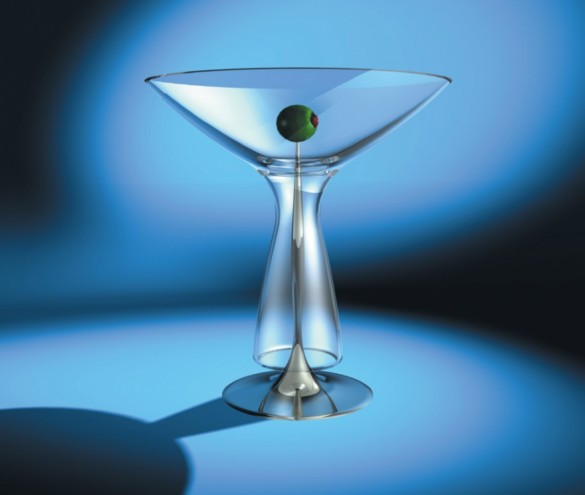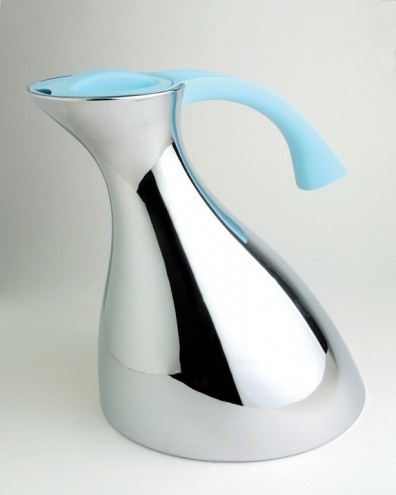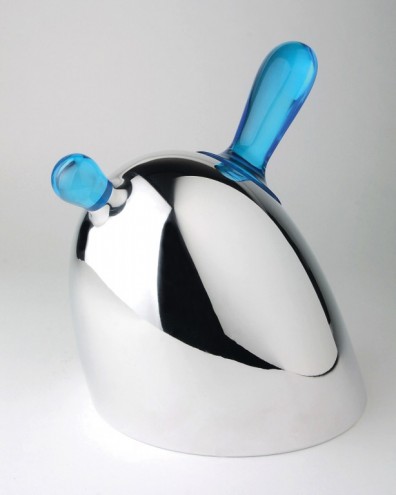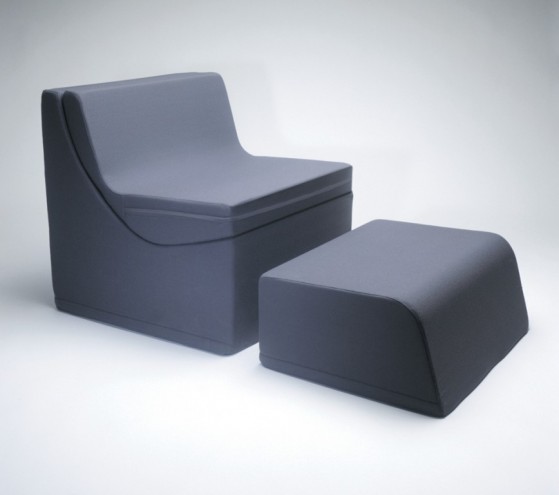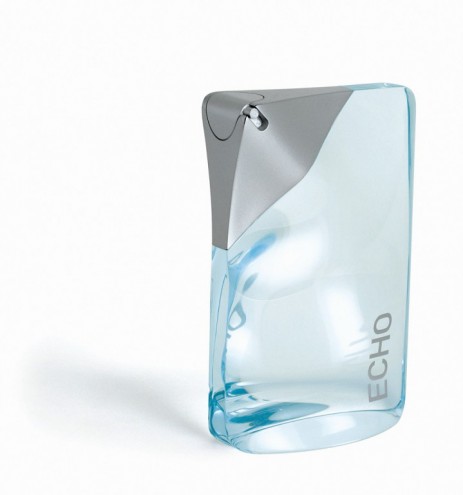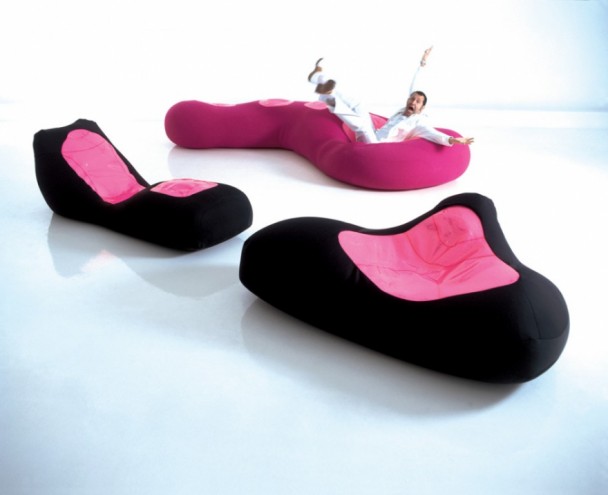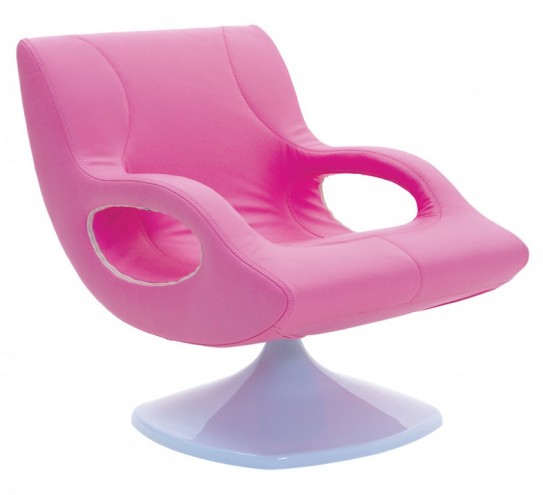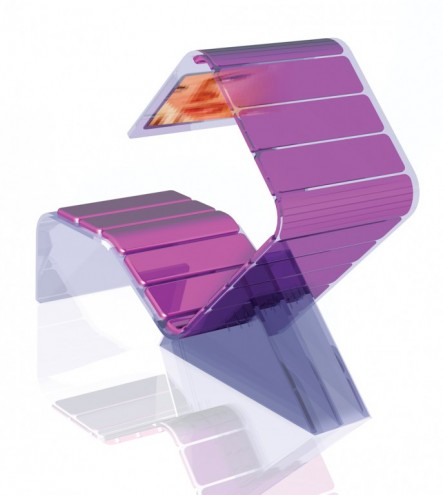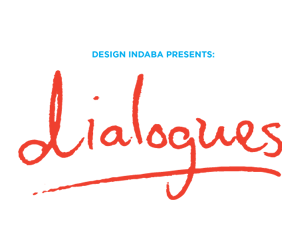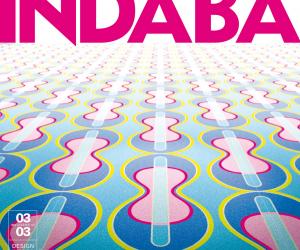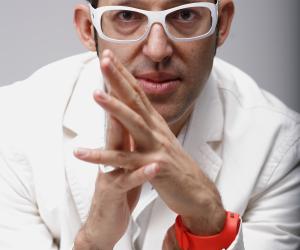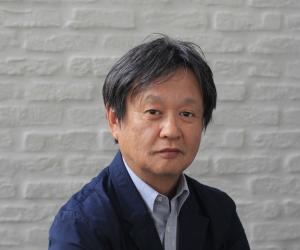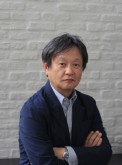Part of the Project
First Published in
Karim Rashid is truly a citizen of the world. Born in Cairo of English and Egyptian parents, he was raised in Canada, studied postgraduate design in Naples, Italy, and today runs his own practice in New York City.
He has won multiple awards for his designs of everything from packaging to restaurant design, and counts Prada, Issey Miyake, Sony, Yahoo!, Cappellini and Umbra among his global clients. He has more than 70 objects in permanent collections, and his designs have been exhibited in museums from Philadelphia and Holland to London and Tokyo.
The vast scope of Rashid’s work reflects his insatiable appetite for the new. If he’s not designing ashtrays and drinking glasses, he’s trying his hand at designer suits and cosmetics bottles. You name it, he’s probably given some thought as to how to make it more aesthetically pleasing, more functional and faster to produce. We asked Design Indaba alumnus and product designer extraordinaire Naoto Fukasawa to pose a few questions to Karim.
For you, what exactly is design?
I act as design editor or cultural editor of our physical world. Ironically, the more product produced the more design is necessary, as the saturation of objects predicate a need to be improved, bettered, with higher quality and new ideas. I am interested in developing products that are accessible to everyone and I believe design is democratic. I design for everyone. Good design, as far as I am concerned, is a combination of these six points: relevant intelligent ideas, functional, expressive (its semiological appropriateness and aesthetic originality), its appropriate use of technology and materials, the product’s impact on the environment (its full cycle) and the product’s quality (including maintenance and durability).
Good design can also shift and change human behaviour and create new social conditions.
Design is really communication to a better, more utopian sense of our physical landscape and well being.
Design and ideas can be disseminated through syntax, lectures, books, films, not just by designing a "thing". Design is every part of life. Design is creative, political and social.
Which designer/design do you respect, and why?
I do not separate designers from other creators in the world. Here is a list of people that I have learned from, that I respect, that shaped some of my philosophies:
Luigi Colani, Ettore Sottsass, Joe Colombo, Philippe Starck, George Nelson, Charles Eames, Isamo Noguchi, Ross Lovegrove, Bruno Munari, Carlo Mollino, Victor Papanek, Frederick Keisler, Shiro Kuramata, Buck Minster Fuller, Toyo Ito, Eero Saarinen, Alessandro Mendini, Laslo Moholy Nagy, Naum Gabo.
Contemporary artists such as Dutchman, Gober, Charles Ray, Koons, Peter Hailey, Andy Warhol, Noriko Mori, Dan Graham, Robert Irwin, Mayijima, Pipilotti Rist, Chapman Brothers, Donald Judd, James Turrell; and philosophers like Paul Virilio, Jean Baudrillard, Guy Debord, Jean Bachlard, Jacques Derrida and Tufen Orel; fashion designers like YSL, Bikkenberg, Hussein Chalayan, JPG, Halston, and the list goes on and on...
What do you think with regards to the relationship between the things you design and the people who use them?
The world is becoming very visually and sensorially savvy. The energy and times are hypertrophic, hypertextual and technorganic. Consumers are perpetually interested in being stimulated, in being excited about their physical environment. It is the residue of the digital age. If the virtual world is so flexible, personalised, complex and aesthetic, why not the physical world?
What do you use as a point of departure for your design ideas?
Every place inspires me - I love and get inspired usually by the unfamiliar, so even the lost local places of industrial parks, airports, hotels in small towns, alleyways in big cites, taxis in London, a gym in Hong Kong, a bathroomin Paris, a prop plane in Sweden, a cinema in Milan, a Renault in Sweden...
Anything that is new to my senses, unusual, odd, inspires me. Beauty is in everything.
Generally I am travelling, designing and coordinating projects from the road. I love being on planes where I can really focus on projects. I can fill a sketch pad on a single European flight (about 100 pages). I write proposals, answer press questions, strategise, develop ideas and directions, and dream about what I really want to do - not what I think I must do. I travel about 180 days a year. I have crazy days in the office. I must sleep 7.5 hours exactly or I have trouble performing. I wake up at 8:00 am and brew the strongest fresh cup of espresso, answer all my emails (usually European or Japanese at that time), then go to the office (I live above my office – a hyperconvenient and enjoyable condition – allows me to work very late), review issues with my office manager, answer more emails, write articles, proposals, etc. then go down the list of projects - meet with each one of my staff (I probably review/work on the design of 20 projects in a day with my staff - I have about 40 projects going so I manage to get to each project every other day), have two or three client meetings, have salad nicoise almost every day and soy shake (in a ten-minute break), drink four strong coffees and one late afternoon decaf - the Do cup of tea - and I keep going until about 8pm - then either go to the gym, go out for dinner, or go to an opening.
I try not to work past 22:00 because I work seven days a week. I perpetually multitask.
When I meet with a client or potential project (I also create many projects myself just because I have so many ideas I want to realise - in fact, 30% of my office is conceptual non-client-for-the-love-of-design projects), I immediately have several ideas, which I sketch right after the meeting in a hotel, cafe or office. Then I keep sketching over and over. Then I put together several of my senior staff and explain the project, the concepts, and they start to develop the concepts digitally with 3-D modelling programs. Then I review it - or keep thinking about the project, I research the possibility of the behavioural issues, new materials, new technologies, etc. and I share this information with my staff. In turn, I have people in the office researching the same pragmatic issues, and getting virtual, solid or real models produced. Each project actually has a very different process, sometimes vertical, sometimes linear, sometimes hypertextual. I used to do the drafting, the rendering, the engineering, the sketching, the entire process - but these days I do not have the time.
A great point of entry for me is the digital age - that has afforded us tools that speed up the process, create better precision, better quality, more variance. (The profession is much less hands on, and more in the third order of prosthetics. CNC, rapid prototyping, solid modelling, new production methods, smart materials, parametric programs, etc. have really completely shifted the profession).
Each project inspires the next, each typology has a commonality to the next typology, each morphology has its relationship. I really make an effort at staying broad. I do not agree with specialisation.
This is just my impression, but I think that there is a strong link between your designs and fashion. Despite fashion trends being short-lived, there exists a certain attractiveness or passion in changes in fashion. What are your thoughts about the attractiveness of design and time?
Fashion has perpetually spun its wheels in circles, recycling. Design is based on new technologies, new behaviours, new materials, and new production methods. Design is infiltrating fashion, because fashion needs to catch up with our product landscape. For example in cosmetics, I designed over the last several years many projects that are changing the "perfume bottle" landscape. I see now everyone catching up. I introduced polymers, plastics, and new "mobile" behaviours that had very little to do with the bottle as an aesthetic sculpture of glass, and everything to do with the way we live and our integration with design and technology.
Remember that many fashion designers are trained as architects - Romeo Gigli, Gianfranco Ferre, etc. - also there has always been a blend of designing and fashion. It is just that designers always looked down on fashion as something superfluous. I always believed that fashion is a critical cultural motivator and shaper and design is instrumental to it. I think it surfaced in the sixties when Luigi Colani did clothes, and in the seventies with Memphis doing jewellery, although even the Bauhaus and the Russian constructivists created clothing and fashion with design and architecture.
Design will be like fashion in the sense that we are getting impatient with things in our lives and that we want to exist in a world that is about new perpetual experiences, not things.
I see a perfectly cycular world developing where we will hyper-consume and shape our individual worlds – and everything will be disposable and 100% recyclable so that we perpetually change our environments, our spaces, our objects, our needs, our experiences – a polygamous object landscape.
The image of you as always wearing white is quite strong. Why is it that you wear white so often? Please also tell us what you think about the colour of designs.
I started wearing white, silver and pink at the new Millennium. I gave away my black wardrobe. Black represents negativity, Armageddon, jealousy, greed. I describe my style as contemporary, infostethic, and addition by subtraction. Style can be learned but the truth is that you are born with an aesthetic eye and sensibility so to really know proportion and balance – that is innate. So style is not just what you wear – it is how you live, how you think, how you exist, to be. White represents purity, clarity, positivity, autonomy, and a tabula rasa – where you are free to think, be and act.
What kind of things would you like to design in the future?
There is so much to do. I want to design cars, planes, clothes, houses, robots and shape the future; but I think that the future is that we will own nothing - this is really nature - we lease cars, we lease houses, and soon we will learn to lease everything - experience it for a short while, and go on to the next. We will create a hyperconsumptive, forever dynamic, ever-vast changing human condition, where everything will be cyclic, sustainable, biodegradable, and seamless. This is Utopia, this is freedom, this is nirvana. All the goods in the world will only exist if they give us a new or necessary experience.
I want to host a design TV show, I want to create music, I want to design a small museum, I want to live in perpetual inspiration, I want to be part of the entire world, working in every country, touching the souls of everyone. I want be smarter, faster, stronger. I want to implant a microchip in my eye that allows me to see everything.
I would like to live in 2030 (this is not a dream). By this point we should have the cure for cancer and HIV, planes that travel at Mach5 or 6, a global paradigm (one global culture), clothes that you spray on your body from an aerosol can, total robotic global production (no manual labour assembly lines), no high-tech products – everything will be immaterial for communication, entertainment and information, multilingual language voice chip, implants, anti-ageing... and Smartoos' intelligent tattoos (a tattoo that has my ID numbers, passport, social security, bank account, e-money, etc. so I never need a wallet, money or credit cards), great virtual sex, creating by waving my hands like a conductor, no paper, no pens, no chairs, just a virtual plane in space that is highly customised, complete reconfigurability and personalisation of goods, we will all design our own objects and spaces - I can’t wait!
We live in a borderless world now; all creative disciplines are blurring, merging, hybridising. In my studio I am designing buildings, interiors, fashion, objects, products, furniture, art, installations, music, film – a Warholian model. I hope to continue this and – although this sounds arrogant – this is all industrial design and all the creative professions will be under the industrial umbrella because this profession is based on industry and technology, all architecture is changing to become an industrial product, fashion is changing to become industrial products, etc.
I think that you are a charismatic designer. Why do you think that you have gained this image? I think that you are a designer who exerts an influence socially. What is your social mission as a designer?
I want everyone to live in a contemporary world. Forget the past – live and experience now. I spread the gospel of design perpetually because I believe that design is a way of living, a way of thinking and a way of being. I have a great deal to say.
Yes, I am charismatic and I believe that designers have taken a back seat for too long considering we shape this world. I am doing new things in the world, there are so many opportunities to change the world, then I change the public knowledge of this profession and future generations of designers will have so much more respect and ease in this profession. I think that it is great because this profession needs stars so that it can become a popular subject and be more instrumental in affecting culture. America has not had a design star since Charles Eames (40 years ago) and thanks to Philippe Starck and a few others we now get an opportunity to have a voice in the world. Design is like music or actors but much more complex, more involved, and we deserve recognition. My scope of work is broadening - I will host a television show on design; I am releasing CD compilations this spring, and creating my own music for fall 2003 release. I am designing clothes, buildings, publishing books. I want to write a book on the “Supreme Lifexistence + Style” – how to be smart, creative, organised, healthy, young and rich. (I am not all these things yet.)
Why do you think people like your designs?
They represent and imbue all the energy, spirit and content that I try to bring to them. I have many unsuccessful projects too. I am quite critical about my work and I admit many times that some objects, ideas and spaces are not perfect. But I am always thrilled when I receive recognition from a consumer that they love my work. I was lecturing in Nova Scotia a few years ago when a 12-year-old came up to me with a limited-edition chrome Garbo can and asked me to sign it, and recently I was speaking in Washington and a 10-year-old with her mother came up to me and she pulled the "King" piece of the chess set out of her pocket and asked me to sign it, and her mother told me that she loves my work and thinks I am the best designer in the world. I was extremely moved and flattered because these children are the next wave of people who will grow up with design as part of their everyday life and are already embracing it at a young age. Ten years ago, a 12-year-old would be interested in Britney Spears - not design, so it is reassuring to know that design is finally making an impact as a public subject and effectual with popular culture. Children always react so positively to my work – because they exist in the moment – that is how I exist – the past is pointless – the future is fugacious.
How do you join together design and regionality or cultural difference?
Digital technology is the instrument for the new Tower of Babel phenomena. The world started as one dialect, one religion, one culture, and then it built the tower of Babel to reach Utopia (heaven – nirvana – god). But god would not allow the folk to reach him or the heavens so he gave everyone a diverse tongue, a diverse culture, diverse beliefs so they could not communicate. This is the beginning of the world as we know it - but we are returning to that global constellate - Utopia - and our one language is binary notation - zeros and ones. We will one day not have cultural differences, only create global pockets of perpetual new ideas from individual thinking. All humans are creative and we will all participate in shaping our global paraditic universe.
I believe that there is no more local - that local implies a way of thinking, a myopic way of seeing human behaviour in a narrow context – but the world is shrinking and global is the only way to perceive culture and to think freely, unobstructed by political, social, historical and nepotistic issues. Local thinking is the nemesis of free spirit and real creative thought in our new globalisation. A new international style seems to have established itself recently. We are all reading the same books, watching the same movies, looking at the same magazines, listening to the same music, we're even drinking the same soda. Inevitably our creative manifestations are starting to be the same. The concept of creative simultaneous discovery is based on shared information and so in turn, the ideas are becoming similar. We are shaping a similar construct, a similar notion of physical space and time. At the same time since there is no single dogma, no single school of thought, no formulae, no doctrine, unlike 50 years ago. Modernism is dead. Rules are dead. Humans can exist and domesticate in with a new freer spirit. The results are everything, everyone, every sensibility, every idea simultaneously in real-time anywhere and everywhere. I love the autonomy of an eclectic landscape, where all human creative thought and ideas are expressed regardless of their origins or of their history.We live in a time of NO RULES! and NO BORDERS, and of real freedom of expression. I like this contradiction, where we are influenced by everything, all information simultaneously, where things appear the same globally, but at the same time things are split into micro-tribes, into thousands of diverse sensibilities, of diverse tastes, views, beliefs, values and feelings. This contradiction (the global village versus an eclectic chaos) is our new contemporary aesthetic world that is a plethora of expressions, signs, logos, where there is no good and bad, a Nietzschian idea beyond good and evil in design.
Please tell us about three of your own designs that you like most or that you perceive to be most representative of your work.
Design is in a new enlightenment where it will touch, effect, affect and be every part of our everyday lives. Design is making people live today, not yesterday, making us be phenomenalogically part of this modicum – design is bringing pleasure, betterment, energy, love and meaning to our physical world. There is no turning back – finally design is here to stay as a qualifier of a better more aesthete life, poetic, smart, functional, democratic and hopefully seamless. I am not sure if I have succeeded yet with this criteria in my work. I like mostly the OH chair because it is five years old and selling more than ever – which means there is an appreciation for the fact that it is democratic (inexpensive), very comfortable, and engineered and moulded in a very innovative way. I would say the same for the Butterfly chair of Magis (engineered like an automobile) in the highest quality ABS plastic. I would also say the new Copco kettles (new technology), the swing chair of Frighetto, the bloob stools and the Kush for new materials and moulding techniques. From a more romantic and poetic idea I like Superblob, Orgy and Krysallis. I generally tend to like the projects that are not in the market, yet. Artists are always most interested in the work they are doing at the moment.
Could you please give a message to South African designers?
I approach environmental sustainability from “material reduction” and deproductisation. I believe that I bring to companies smart efficient minimal sensual proposals that can reduce their SKUs (numbers of styles/variations in their lines). One product today should replace three at least - it’s about editing.
A designer will be a cultural purveyor and developing products that people want to elevate experiences, developing proposals that actually really change our lives and bring a heightened - more enjoyable - experience to life.
There are several strategies not just to deproductise but to develop successful products:
- Design objects that meet all the criteria not just one. Beauty, performance, meaning, cost, seamless production, no hand labour, ease of assembly, smart material, recyclable, spatial, etc.
- Show companies that quality creates higher margins and greater brand loyalty.
- Subtract SKUs that are complex, confusing, noncommunicative, labour-intensive, made from too many parts, high maintenance, culturally irrelevant, etc.
- Design flexible, extensive, relaxed, module, interchangeable, reconfigurable, multifunctional products.
- Remove collateral, streamline distribution, manufacture on demand, drop-ship, local manufacturing, global positioning, etc.
- Promote, educate, disseminate a direct simple philosophy - design experiences versus objects. Form follows subject.
I want to reach Utopias, one global culture, one religion, the religion of love, harmony and beauty and high-energy.
Karim Rashid is presently designing LCD televisions, soap bottles, shampoo bottles; cosmetics for Miyake, Prada, Davidoff; packaging; furniture for Cappellini, Felice Rossi, Driade, Edra, Frighetto, Pure Design, Zerodisegno, Ferrachi Casa, Nienkamper, Magis, De Sede and others; glassware for Mglass, Nambe, Covo, Egizia, Salviati, Decorum, Arnolfo di Cambio; products for Guzzini, Umbra and Mikasa; lighting for Foscarini, Fabbian, Artemide and Nemo; interiors of restaurants in New York City, Moscow, Mexico and Las Vegas; architecture in London and Athens; hotel interiors in Los Angeles and San Francisco; his own shop, retail shops in Dallas and Denver; a clothing collection; jewellery for Golay in Switzerland; a Greek water bottle; watches, kettles, a thermos; carpets for Dreschle Teppich and L’Art du Temps; toys for Bozart; a hot tub, bath tubs… Street furniture in Tokyo, a new book, a TV show, a bicycle for Biomega, luggage for Leeds, wallpaper for Marburger in Germany and Wolf Gordon, dishware for Wovo, and he just completed editing the 2003 International Design Yearbook. He is also doing some art installations and painting shows in Graz, New York City and Paris and some objects for charities globally. He just launched music CD compilations with Never Stop Entertainment and a retrospective in Seoul, Korea. The list goes on…

